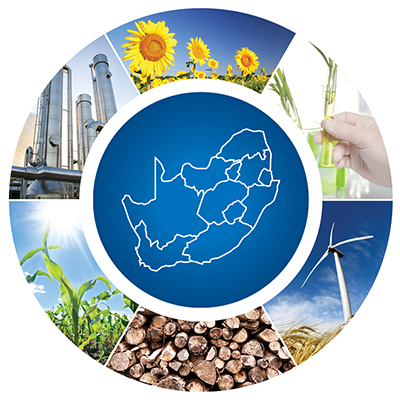Agriculture
- Purposely cultivated crops
- Crop availability
- Agricultural residues
- Sugarcane
Purposely cultivated biomass can be an important source of energy generation, and, dependent on the type of crop may yield one or more of the main classes of biomass –starch, sugar, lignocellulose, and oil, in varying yields. However there is potential conflict between purposely cultivated crops and food security, details of which are discussed within the attached summary document.
Supplementary information is available here:
Estimates of annual yield from different BioEnergy Crops were derived from the agricultural potentials presented within the Agrohydrological Atlas:
Supplementary information is available here:
Agricultural residue is the non-food component of crops that remain after crops have been processed. There are two components to agricultural residue; field residue, which consists of biomass such as stalks, stems, leaves, and seed pods which are leftover after a crop has been harvested and process residues, which consist of biomass that remains after a crop has been processed into a usable resource. Process residues include husks, seeds, bagasse, molasses and roots.
Residue is frequently left in the field to improve soil condition. However, due to the high starch content and lignocellulose component of agricultural residue, it is also possible to for it to be used as a bioenergy feedstock.
Supplementary information is available here:
Sugarcane has the potential to serve as a primary BioEnergy feedstock through the conversion of stored sugars into alcohols via fermentation. Additionally, sugarcane residue (field residue and bagasse) can serve as a BioEnergy feedstock through the provision of lignocellulose.
Supplementary information is available here:
Waste
- Assessment of waste
- Waste models
- Used cooking oil
Commercial as well as domestic waste streams have the potential to serve as a BioEnergy Feedstock.
Municipal solid waste is a sizable resource, but has partial immediate potential for electricity generation, largely because of the low percentage of sites with proper permits, and because solid waste removal is not formalised for a sizable percentage of the population.
This leads to three main considerations: Combination of sewage sludge and solid waste organic component to increase the availability and improve the economy of scale of electricity generation from these sources; There is significant upside potential should service delivery and permit processing improve in future; and options exist for the deployment of community or domestic digesters (BioEnergy Atlas Synopsis Report 2015)
Supplementary Information is available here:
Due to lack of detailed information regarding the composition of various waste streams the volumes of different waste types were modelled based on the composition of the households that create the waste.
Supplementary information is available here:
Used cooking oil (UCO) consists of fats and oils originating from commercial or industrial food processing operations, including restaurants, that have been used for cooking or frying.
UCO represents a significant waste stream from the cooking industry. Current methods of disposal typically include disposal to landfill sites or into sewerage networks where it can potentially cause blockages.
Supplementary information is available here:
Forestry and Timber
- Invasive Alien Plants
- Forestry residue
- Fuelwood
Invasive Alien Plants Species (IAPS) in South Africa represent a significant threat to biodiversity, livelihoods and water availability while also representing a significant woody biomass resource.
Rural development programmes such as Working for Water and Working for Energy have the potential to use biomass beneficiation in the form of bioenergy production as a way of providing additional programme funding while also contributing to broader energy-job-sustainability nexus objectives.
Options include:
- Pelleting or chipping of lignocellulose biomass in areas close to existing coal-fired power stations, with a view to co-firing.
- Supplementing or replacing coal- and gas-based refinery feed with lignocellulose biomass feedstocks.
- Development of small electricity-generating capacity in areas of poor provisioning and extensive rural firewood use.
- Replacement of fuelwood use by pelleted fuel and efficient pellet-burning stoves.
- Sale of biomass pellets to overseas markets.
Supplementary Information is available here:
- Biomass from invasive alien plants
- Estimates of potentials, yields, and current utilisation of invasive alien trees
- Future electricity generation capacity (RIRP)
- Current energy electricity generation
- The bounds of the possible
- The next few years: an establishment view
- Infrastructure and accessibility
- Alternative future electricity generation
Forestry residue consists of organic by-products from forestry processes. This includes thinning, cutting stands for timber or pulp or other uses that yield treetops, branches or leafy biomass, which can be utilised for bioenergy production.
The availability of forestry residue for bioenergy production is strongly dependent on the combination of land management practices, site soil characteristics, species and harvest regimes that the forestry company is implementing within their landholdings.
The Institute for Commercial Forestry Research (ICFR) has developed decision support tools for the BioEnergy Atlas with the aim to assist landowners to determine the volume of forestry residue that can be safely removed from thier sites and understand what the associated impacts on soil nutrient balances are likely to be.
The decision support tools and data are provided here:
- Forestry residue availability – Regional forestry nutrient budgets methodology and scenario development guideline
- Regional forestry nutrient budgets
- Nutrient loss scenarios
- Harvested forestry residue
- Eastern Cape and KwaZulu-Natal forestry potential
- South African forestry area information
- Forestry residue availability – Eastern Cape and KwaZulu-Natal forestry species suitability
- Forestry residue availability – Eastern Cape and KwaZulu-Natal forestry potential methodology
- Forestry residue availability – harvest residue assessment methodology
- Forestry residue availability – South African forestry area information methodology
- Harvest residue potential
Fuelwood is a major energy source for rural cooking and heating yet remains an inefficient use of biomass, which also significantly impacts air quality.
The volumes of fuelwood used in South Africa are estimated below:
Infrastructure + Energy + Transport
- Infrastructure
- Energy
- Transport
The following datasets provide information regarding South Africa’s current and planned energy infrastructure and energy production.
Infrastructure that serves the energy sector, and that could potentially be used in future, was evaluated in respect of proximity to economic activity, population (specifically looking at poor rural households) and availability of biomass including: Electricity generation/storage/power stations coal, hydro, solar, wind and biogas – including operational and decommissioned facilities, and planned facilities reflected by National Energy Regulator of South Africa (NERSA) permits; and transmission and distribution of electricity (existing and planned). Gas and liquid fuels fuel and gas depots, and refineries as licensed by NERSA.
Supplementary information is available here:
Future electricity generation capacity (RIRP)
Current energy electricity generation
Assessment of implications of future energy resource plans
The next few years: an establishment view
South Africa’s Energy Portfolio has increasingly shifted away from fossil fuels as an energy source towards renewable energy. For bioenergy projects to be feasible, there is a requirement for the unit costs of production to be price competitive with competing energy sources. The following section provides information regarding unit costs of production for energy sources, energy density, and information regarding the public attitude towards the shift in energy types.
Supplementary information is available here:
- Costs of traditional and alternative energy – to be revised
- VALUE OF FEEDSTOCKS AND RESIDUES – to be revised
- Energy use and provisioning
- South Africa’s future energy portfolio
- The energy density of fuels
- Attitudes towards alternative energy sources
The transportation cost of BioEnergy feedstocks contributes significantly towards the unit price of a BioEnergy source.
The Bioenergy Atlas for South Africa has developed models for determining transport costs to a facility. First via offroad from the feedstock location to the nearest roadside depot point and then secondly from the roadside depot towards the modelled facility location.
Vehicle parameters and various other transport considerations are captured in the supplementary information below:
Impacts
- Environmental Impacts
The creation of bioenergy products has concomitant impacts on the ecosystems and environments that those feedstock sources are derived from. For example, harvesting alien invasive vegetation for use in BioFuel will affect water availability and local nutrient cycling and the local carbon cycle.
The BioEnergy Atlas contains information regarding the nature of these impacts, and the information is presented in the documents below:
- Impact assessment –review of considerations
- Estimates of carbon cycle effects of major products and feedstocks
- Summary table of local and global data on LCA carbon emissions
- Estimates of land use effects of major products and feedstocks
- Biodiversity impacts of monoculture and land use changes
- Summary: impacts of selected technologies and feedstocks
- Land use impacts



